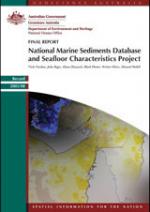National Marine Sediments Database and Seafloor Characteristics Project
Geoscience Australia, 2005.
Download

About the report
The National Marine Sediments Database and Seafloor Characteristics project is a collaborative effort between the National Oceans Office and Geoscience Australia. The aims of the project were:
- to locate, identify and collate existing information on the nature and distribution of marine sediments within the Australian Marine Jurisdiction
- to develop the MARS sediments database within Geoscience Australia and populate it with collated data to provide a national fundamental dataset, with publicly-available data
- to analyse and map readily available sediment data for the Northern Planning Area as a first priority to provide information for the Northern Region marine bioregionalisation
- to analyse and map an agreed selection of sediment data for the Australian region to provide information for the National Benthic Marine Bioregionalisation
- to detail in maps estimates of sediment mobilisation due to waves and tidal currents for Australian waters less than 300 m depth
- to strategically analyse the role of sediments and other seafloor characteristics information in marine bioregionalisations and, based on an assessment of relative benefits, recommend options for further research and data collection
- to interact with the National Marine Bioregionalisation Integration project teams to ensure sediments and other seafloor characteristics information is applied correctly in the National Benthic Marine Bioregionalisation.
The creation of the MARS database marks the transition to a new era of easy internet access to quantitative seafloor information. This is the first project to critically assess the quality and coverage of Australia’s seafloor sediment data on a national scale.
The initial phase of the project was the identification and collation of sediment data. The compilation of data generated from the scientific analysis of samples (quantitative data) was given priority, as these data would allow seafloor sediment characteristics to be assessed, modelled and presented with greater confidence than previously attempted.
In total, 80 individuals representing 38 organisations were contacted. By the end of the data collation phase, the MARS database contained about 25,000 samples for which 138,000 properties had been recorded.
This represents a significant advance in making quantitative sediment data available to researchers, stakeholders and managers alike.
Maps of sediment properties were produced using validated quantitative data for two regions: the Northern Planning Area (NPA) and the whole of the Australian Marine Jurisdiction, excluding external territories.
These maps show the distribution of measured grain size data (weight percent gravel, sand and mud), calculated mean grain size, as well as sediment classification based on the Folk scheme (Folk, 1954), and carbonate content.
Mean grain size data for six of the marine domains were used to model sediment mobility in waters less than 300 m depth, using Geoscience Australia’s GEOMAT package.
The results of the modelling were produced as maps of tide and wave exceedance, and an energy regime regionalisation.
As a direct result of this project, the MARS database is now an important scientific and educational resource for those requiring detailed information on seafloor sediment characteristics within the Australian Marine Domain areas.
The maps generated by this project show the level of detail and type of presentation possible when using quantitative data, but significant gaps in measured data coverage were also identified. Some 70 per cent of the total marine domain remains unmapped in terms of measured sediment data.
Much of this area is off the continental shelf, although gaps in the data coverage on the shelf are significant, particularly in the South-west and West-central Marine Domains
Strategic directions for improving the data coverage include the analysis of existing sediment samples from Australian and overseas repositories.
A valuable resource of seabed samples stored in Australia and overseas has been identified. These samples, if analysed, have the potential to double the existing overall measured data coverage for Australia’s Marine Domains and would provide a cost-effective way of generating new data. The South-west Marine Domain would provide a useful pilot study to test the utility of analysing existing material.
Reanalysis of existing samples would provide consistent and appropriate data, particularly for sediment mobility modelling, where the parameters measured are not necessarily the most appropriate to model sediment behaviour.
Enhanced collection of existing data requires further development of relationships with data owners. Funding in support of this would facilitate collection of non-digital data, particularly from universities.
In addition to continued acquisition of sediment data, continuing research into the links between geological properties and biota is important to better inform the use of geological proxies in bioregionalisation.
Geological data have obvious benefits: even with significant gaps in quantitative sediment data, the coverage is still far greater than for biological data.
Additional development of the GEOMAT model would allow it to be better applied to bioregionalisation. In particular, the ability to calculate the mobilisation for a full spectrum of grain sizes would enable the model to predict the minimum grain size which is mobilised for some significant period of time.
This would provide a better understanding of the fate of sediment input to the continental shelf and how this relates to a regionalisation based on dominating energy regimes.
Learn about your marine parks
Stay in touch
Subscribe to receive important updates about your marine parks. Enter your email address and click "join now".







